It’s become a tradition for the Progressive Dairyman team to scope out new products, ideas and innovations to share with readers following World Dairy Expo in Madison, Wisconsin. The 2018 show, with the theme of “The Next Frontier,” had plenty to offer.
Progressive Dairyman editors Walt Cooley, Karen Lee, Peggy Coffeen, Lora Bender, Jenna Hurty-Person and Audrey Schmitz provided their observations about “cool stuff” that caught their attention at the show.
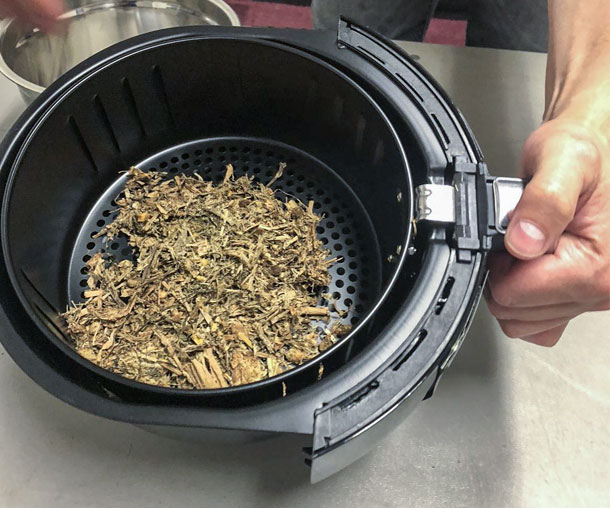
A new way to test TMR for dry matter
The new idea for a quick test for TMR dry matter began with a bad batch of French fries. Two European employees of Diamond V who have been using the new method in the company’s TMR audits brought the idea to World Dairy Expo to share with U.S. producers.
The new method was an accidental discovery. Diamond V employee Peter van der Vegt’s wife wanted him to eat healthier and purchased a household air fryer to cook the family’s fried foods. Van der Vegt said the air-fried food tasted “terrible” and looked for a different use for the appliance. He and his colleague Paul Willems found that the air fryer was particularly good at drying down TMR samples.
During the show, they demonstrated how a 3.5-ounce sample of TMR could dry down at 250ºF in 30 minutes using the automatic air fryer. They said the method is preferable over other methods because it doesn’t have to be watched while being tested like microwave, conventional oven or Koster methods require. There’s no way to start the dry matter on fire using this method, they said. The new method also allows for testing a total ration’s dry matter because the fines in the ration are trapped inside the fryer bin and will not blow away or be lost like with other methods.
The air fryer they used for the demonstration cost less than $100. They used a household kitchen scale to measure out the initial feed sample. The sample they had from a Michigan dairy tested at 40 percent dry matter during the half-hour demonstration.
—Editor Walt Cooley
Photo by Walt Cooley.

A glimpse at mixed reality for herd management
Dutch-tech provider Nedap provided a sneak peek of what could be the future of herd checks during a private meeting between Progressive Dairyman editors and company representatives.
The company previewed a first-person video capture using Microsoft’s developmental product Hololense that showcased the augmentation of herd data from the company’s activity monitoring sensors and real-life video.
The video captured the view of a herdsperson looking over a pen of cows. Data about each cow was displayed in a virtual ID tag over the cow’s back. These tags could expand if the user focused eye motion on one particular cow’s virtual tag and then motioned in front of the mixed-reality goggles with a finger pinch. Individual cow data such as pregnancy status, days in milk, lying time and rumination time could be seen in each of these expanded windows. The video also showed the herdsperson locating a cow by following a green arrow, which pointed to where the cow was lying in a stall in the pen.
The company says it’s experimenting with mixed reality to make it easier for dairy farmers to digest the activity monitoring data they already collect on their cows. Nedap’s activity monitoring technology powers the collars and pedometers offered by GEA, Boumatic, Lely and other U.S. providers. The mixed reality display couples a tag’s ability to identify cows, gather data about them and locate a particular cow in a pen to make data display virtual.
The first public display of the augmented reality solution for dairy farms will occur at EuroTier 2018.
—Editor Walt Cooley
Photo courtesy of Microsoft.
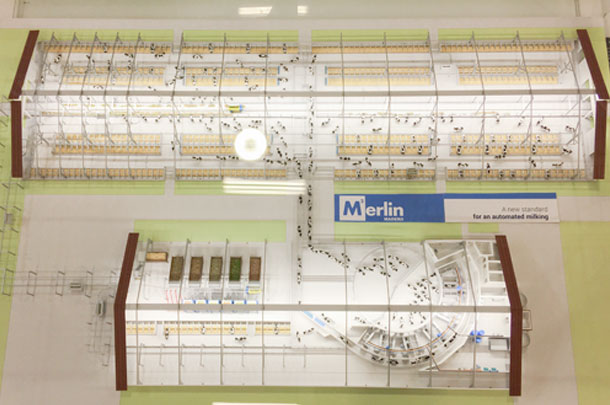
Madero introduces new automated milking system, robotic batch milking concept in the U.S.
Madero Dairy Systems, known for its rotary parlors and specialized, sensor-based, computerized management systems, introduced two new options for those interested in adopting automated milking.
First, it is bringing the Madero M2erlin to the U.S. market. This box-style automated milking system that comes from the United Kingdom features a dual entry and exit so cows can access or leave the unit from the front or side. Its attaching arm is equipped with electric drive for a faster, more precise attachment and low energy consumption.
Second, it displayed the new automatic milking system unit as part of the robotic batch milking concept. This idea was originally introduced in Germany a few years ago. In this system, multiple box units are placed around a central holding area. One person is able to usher the cows to the holding area and then has roughly 40 minutes to complete other tasks, such as treating those automatically sorted off to the side, while the cows enter and exit the robots and return to the pen on their own.
—Editor Karen Lee
Photo by Karen Lee.
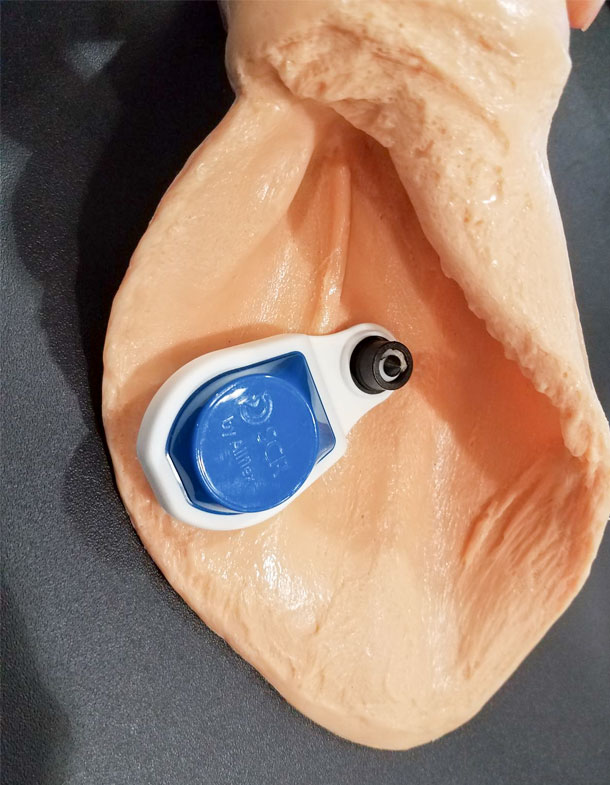
Allflex Livestock Intelligence launches calf-monitoring system
The Allflex Young Stock health monitoring application is an eartag and software system that senses and records multiple actions to detect the onset of health issues very early, preventing impact on growth or future performance, and reducing drug use and mortalities.
The tag can be attached to a newborn calf to monitor resting, suckling, eating, rumination and many other behaviors. The data is then displayed in a correlated health index score that allows calf raisers to see how the calf recovers from birth, as well as other transitions between feeding methods or housing in its first several months.
With the ability to monitor calves from day one, dairy producers will now have the opportunity to collect life cycle data to advance animal health and productivity in their herd.
—Editor Karen Lee
Photo by Karen Lee.
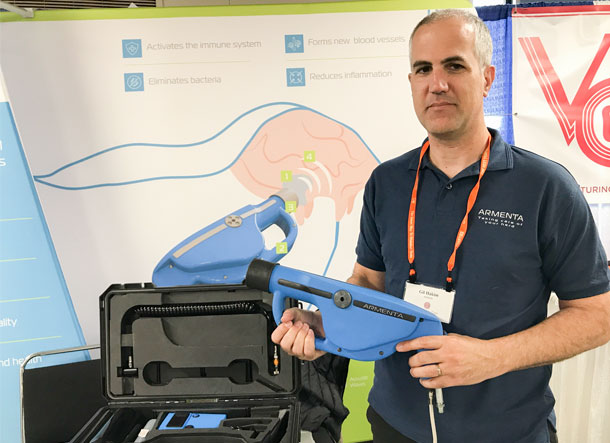
Shockwave technology introduced for mastitis treatment
Armenta Ltd., a company focused on developing new noninvasive, nonantibiotic therapies, showcased their Acoustic Pulse Therapy device this year at World Dairy Expo. This patented system is designed for treating subclinical and clinical mastitis in dairy cows. The hand-held device is air-based and uses compressed air to apply acoustic waves to affected udder quarters.
Low-intensity shockwave technology has been widely documented over the last 35 years for treating human patients with inflammatory diseases. This therapy produces new blood vessels, reduces inflammation and improves tissue function.
The founders of Armenta previously worked for companies that produce and manufacture shockwave devices. They found out about inflammation diseases in dairy cows by chance and decided to explore creating a system specific for dairy cow use.
—Editor Audrey Schmitz
Photo by Audrey Schmitz.
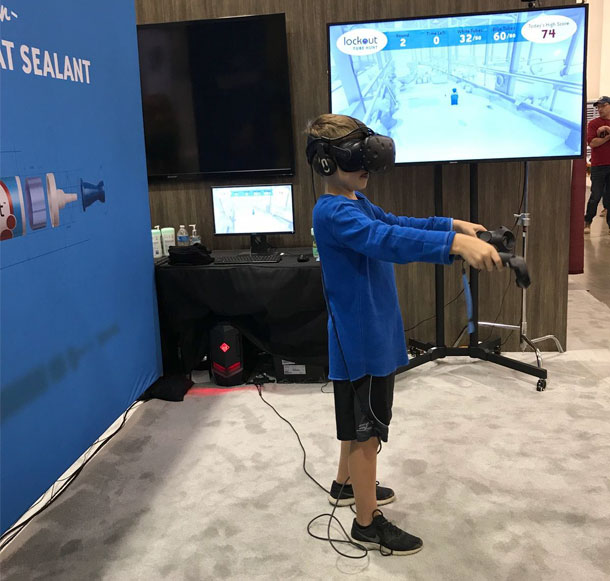
A virtual reality game differentiates blue teat sealant
This year Boehringer Ingelheim’s booth featured an interactive video game to highlight their new Lockout teat sealant. Attendees at the expo tried their hand at the game by wearing a virtual reality headset and holding a clicker-pointer in each hand. The head-mounted display provided a video image of an alleyway inside a freestall barn as well as stereo sound and head motion tracking sensors.
In the first round of the game, users tried to find and shoot as many white tubes of teat sealant as possible in a select amount of time. In the following round, the white tubes were replaced by blue tubes. By playing the game, producers could make the clear connection that the blue tubes of sealant were far easier to see than the white, emphasizing the advantage of Lockout’s blue color.
—Editor Audrey Schmitz
Photo by Audrey Schmitz.
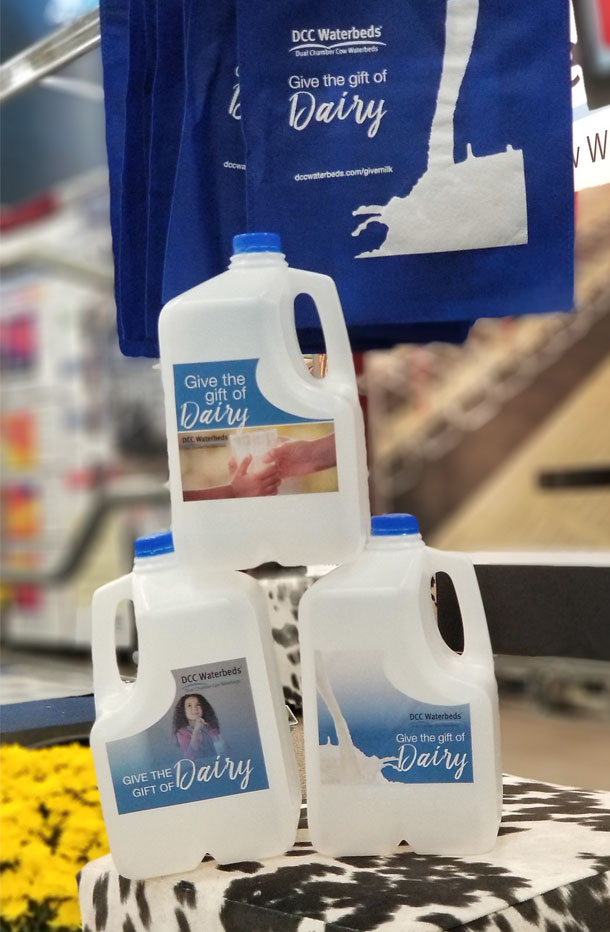
A giveaway that gives back
One of the most meaningful giveaways we came across at World Dairy Expo was not just another cap or keychain. Rather, it was a gift that keeps on giving. Advanced Comfort Technology Inc. announced that between Oct. 1 and Dec. 31, 2018, they will donate the value of one gallon of nutrient-rich milk (up to $4 per gallon based on local costs) to a local food bank for each DCC Waterbed sold. This fall promotion partners with the Great American Milk Drive in the U.S., as well as local food pantries in Canada.
“With the change and uncertainty in our industry, we want to give some focus and recognition to dairy's impact on our communities. Farmers feed the world, and dairy's contribution to this cause is tremendous,” said Amy Throndsen, COO of Advanced Comfort Technology. “We can't say what the future holds, but we can make a difference today by giving milk to those in need. And, in doing so, we can celebrate our farmers, our industry and the wholesome dairy products they provide.”
—Editor Peggy Coffeen
Photo by Lora Bender.
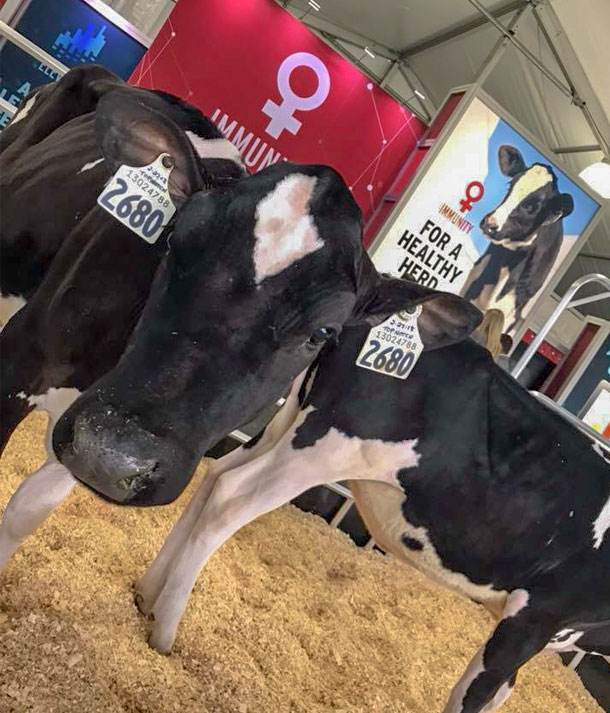
Breeding for healthy cows just got easier
In the quest for healthier cows, Semex announced the Elevate program, featuring Immunity+ female genomic testing, at the 2018 World Dairy Expo.
The real-time, cloud-based Elevate program removes the desktop clutter of papers and spreadsheets by utilizing an app to automatically track and upload genomic testing results. It also works hand-in-hand with the company’s customized mating programs.
The new genomic test ranks and selects cows based on their individual Immunity+ genomic test results, therefore identifying the females in the herd most resistant to disease. Armed with this knowledge, dairy producers can choose to use sires with higher immunity to improve the low-immune females, and make informed herd growth strategy and management decisions.
Two heifers with exclusive immunity genomics were given away in a live drawing at the show.
—Editor Peggy Coffeen
Photo courtesy of Semex.

Ultra-durable bucket may make feeding calves easier
Calf-Tel has released an 8-quart bucket made of a co-polymer polypropylene, making it nearly indestructible. In fact, wishing to test the bucket’s durability, Brandon Sowder, director of sales for Calf-Tel, decided to run the bucket over with a tractor. Surprisingly, the bucket popped back up, virtually undamaged and able to hold water. Check it out in this video.
The pail has rounded bottom edges, making it easier to clean and easier for calves to access starter, water and milk, which can help reduce waste. In addition, the bucket sits nearly parallel to the ground, giving calves easier access to their food and water. Finally, the buckets are available in two styles, allowing producers to attach them to wooden hutches, metal pens or the company’s hutches without using hardware or pail holders.
—Field Editor Jenna Hurty-Person
Photo by Jenna Hurty-Person.
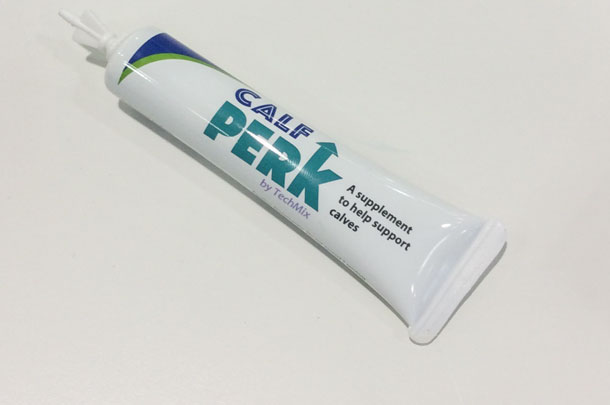
Green tea may help save newborn calves
Caffeine is possibly one of the most widely consumed drugs in America today, providing many with the energy they need to complete their day. Some enjoy it in the form of morning coffee or tea, while others jump right for an energy drink. However, this common drug is not just for humans anymore as Techmix has captured the power of caffeine in the form of Calf Perk, a new natural supplement for challenged or lethargic newborn calves.
This product gives calves a boost of energy shortly after birth, thereby increasing the calf’s body temperature and respiration rate, and giving those that had a difficult birth a better chance at survival. In addition, calves that receive this tend to start moving around sooner and have enhanced vigor and suckle reflex, which can help with colostrum feeding.
The product is derived from concentrated green tea and comes in a tube, which can be squirted onto the calf’s tongue, where it is quickly absorbed by the animal.
—Field Editor Jenna Hurty-Person
Photo by Jenna Hurty-Person.
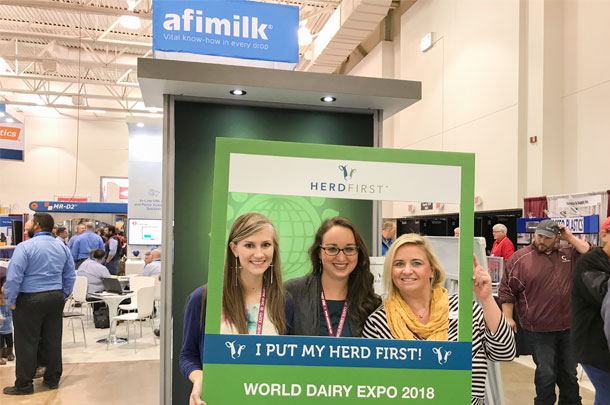
Cargill continues #putyourherdfirst campaign at World Dairy Expo, donates to The Great American Milk Drive
To celebrate their new HerdFirst calf and heifer nutrition line, Cargill continued its #putyourherdfirst Facebook campaign at World Dairy Expo. Attendees could take a photo at the company’s booth with the HerdFirst frame and share it on Facebook with the hashtag #putyourherdfirst.
For every person who did so, the company will donate three servings of milk – the recommended daily amount for Americans – to The Great American Milk Drive.
Cargill will continue the campaign through the end of October. Those interested in participating should use the HerdFirst Facebook frame and share it with the hashtag #putyourherdfirst. For every person who does so, Cargill will also donate three servings of milk.
To date, the company has donated 65,000 servings of milk, 1,000 of which came from World Dairy Expo participation. This puts them on track to achieve their goal of 100,000 servings.
—Field Editor Jenna Hurty-Person
Photo by Jenna Hurty-Person.
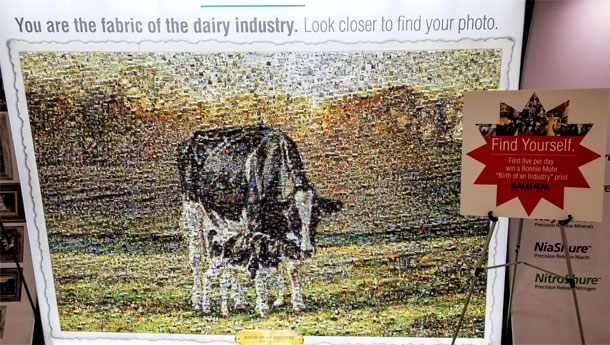
Balchem presents the Real Faces of Dairy
From afar, this Bonnie Mohr print, “The birth of an industry,” stood out in the crowd. Intrigued and taking a closer look, we could see that the print was in fact a mosaic of thousands of individual photos – photos of dairy families from across the country. Photos were collected online, then voted on to find the photos to be featured in the Real Faces of Dairy 2019 calendar, along with being featured on the booth. Visitors to World Dairy Expo, who participated online, were encouraged to locate their photos they submitted to win the print by Bonnie Mohr.
Beginning in 2016, Balchem started this project to honor and celebrate individuals who have shaped and will shape the future of the industry. Through sharing photos, stories, videos, roles and innovations, the Real Faces of Dairy project focuses on providing tools and talking points for dairy producers to tell their stories to their neighbors, friends and others in their communities.
The website features photos of dairy producers and their families while offering photo and video contests, educational articles, news and resources.
—Editor Lora Bender
Photo by Lora Bender.
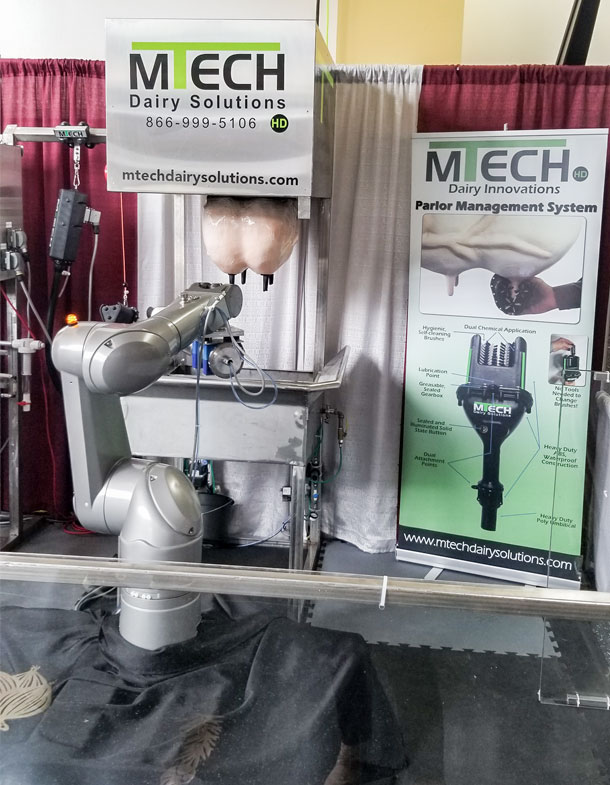
Connected innovations on display at the MTECH Dairy Solutions booth
Two new innovations – connected but not yet available on the market – were showcased by MTECH Dairy Solutions. Sharing their new technology with consumers and potential distributors, this booth was voted number one by World Dairy Expo officials.
MTECH is a Wisconsin-based company founded by Phil Mlsna, a dairy producer who is currently milking 2,500 cattle. Mlsna has proudly invented not only a robotic teat scrubber prep system, which provides an efficient and reliable way to wash, disinfect, brush dry and stimulate cows before milking, but also a camera linear actuator with an automatic teat applicator (ATA) to precisely apply teat dip.
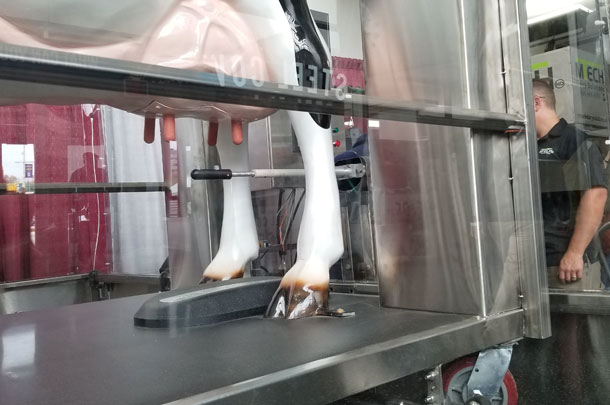
Here’s how it works: As the cow moves along the rotary parlor, the camera linear actuator quickly moves in-and-out from below looking up in between the cow’s legs, instantly collecting the precise location and schematic of each teat placement. It has a dual purpose; the camera linear actuator also applies teat dip while capturing the data, such as width, length and the end of the teat, to electronically connect with the robotic teat scrubber prep system. The information is then automatically sent to the robot so that the exact dimensions of each teat is known for precise individual application, using the detailed measurements for how deep the brush is to go up and down.
Giving each cow a “spa treatment,” the company claims to provide a better milking experience for the dairy cow herself as well as the people operating the milking systems. First to be available on the market will be the robotic teat scrubber prep system, followed by the camera linear actuator with ATA. The camera linear actuator unit is also currently being tested for a parallel parlor application. The hand-held version of the teat scrubber is presently available for purchase. If you’re interested in learning more and want to keep up-to-date with product development, visit the MTECH website. ![]()
—Editor Lora Bender
Photos by Lora Bender.
TOP PHOTO: Progressive Publishing staff gather for a group photo at World Dairy Expo 2018. Photo by Lora Bender.




